We live in an era of instant gratification. We want things now. We aren’t prepared to wait. And if we do have to wait, we know we can vote with our feet and choose a different company next time.
That’s why on-demand delivery and on-demand mobility companies have thrived in recent years, with almost 90 million Americans having used an on-demand service.
Consumers can now order almost everything from the comfort of their own home, whether that’s a ride, a TV show, food, or even essential medicines.
Yet despite the incredible popularity of these services, it can be difficult for on-demand businesses to survive.
On-demand delivery companies –– especially in the fast food industry –- often operate on razor-thin margins and can struggle to just break even. Poor reviews regarding late arrivals, lack of selection, and quality can hit hard.
Take Deliveroo. Its small margins and crippling costs left it on the brink of collapse when some restaurants in the UK not only closed dine-in options, but also shut their restaurants completely due to the Covid-19 pandemic.
Anything that impacts their bottom line can have disastrous consequences.
So, how do on-demand companies ensure speedy delivery and accurate ETAs, provide the range of products and high quality that consumers demand, and generate profit?
The key is to control what you can control, and optimize everything you can control, including unpredictable elements like the weather.
Predicting the Unpredictable
Weather doesn’t run on a schedule, unfortunately. Unexpected (or even forecast) weather can be problematic for on-demand delivery services. Everyday weather is hard to manage, but the kind of extreme weather events we’ve seen in recent years, such as heatwaves and storms, only make it worse.
Yet this is often the time when consumer demand picks up and on-demand services find their operations stretched to their limits.
When a blizzard blew through New York in 2015, GrubHub documented a 135% increase in cheese pizza deliveries and a 134% increase in pepperoni pizza deliveries compared with a typical Monday.
On-demand delivery companies do have processes in place to deal with everyday and extreme weather, such as limiting restaurant choice to venues nearby and paying their couriers more to work in these challenging conditions.
But you can’t plan for every scenario unless you’re prepared in advance.
Protecting Drivers in Extreme Weather
Driver safety is a key concern in the case of extreme weather. There are plenty of internet forums where people discuss whether you should even order in at all when the weather outside is frightful.
Road conditions can change in the blink of an eye. Due to safety concerns for drivers, on-demand companies are sometimes forced to suspend their services. In February 2020, Uber Eats halted service a few hours before a freak snowstorm hit Seattle. That kind of weather is unusual for the area, which made the situation even more challenging.
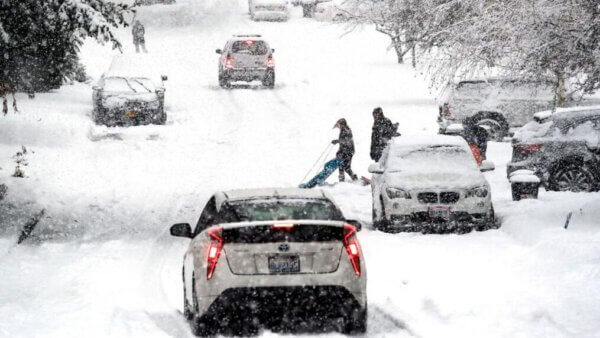
However, it still maintained service during the polar vortex in late January in markets such as Detroit. The company stated that they still had delivery partners willing to work in the cold conditions, and so could continue to offer service.
Not all on-demand services have adequate processes and provisions in place to deal with unexpected weather events. They react in the moment (if they react at all), instead of planning ahead and optimizing their operations to meet demand and changing conditions.
For example, some restaurants and on-demand apps still take orders for customers miles away even when they know deliveries will take much longer due to adverse weather. One delivery driver complained that GrubHub accepts orders seven miles away when it is snowing despite the journeys taking much longer than normal.
According to the driver, he normally averages about 2.4 deliveries per hour, but when there is heavy snow, it’s down to 1.8. If the food takes too long and the on-demand delivery service doesn’t provide an initial ETA, then update that as conditions change, customers often cancel before the food even arrives. This not only results in a loss of business but also hurts the relationship with the customer and doesn’t deliver the kind of experience that today’s consumers expect.
The challenge for on-demand delivery companies is to provide the same level of service and quality at a competitive price, while not compromising too much on choice and keeping couriers (or whatever method of delivery they choose) safe whatever the weather.
Understanding Demand and Offering Accurate ETAs
Just like restaurants and retail brands, on-demand companies need to build loyalty, gain trust, and deliver a great experience if they want to generate a reliable revenue stream. Yet they still use static order tracking and a simple notification system that only lets you know if your delivery has been dispatched. This isn’t enough to satisfy today’s consumers.
Your buyers expect access to a driver’s location in real-time, especially when they have ordered time-sensitive goods.
When deliveries arrive late, customers get annoyed, even if it’s because of a perfectly acceptable reason like poor weather. They are more likely to cancel their order and decide to switch to one of your growing number of competitors. That’s why you need to keep them informed.
Here is how important ETAs are to customers and your company’s chance of success:
- If the actual delivery time is later than the expected arrival time, 69% of people are likely to consider a different restaurant the next time they order (within the 69% group of respondents, 19% said very likely).
But the ability to accurately predict delivery times is not only key when it comes to customer loyalty, satisfaction and retention, it also helps businesses better manage operations, equipping them with the necessary data to know when they can dispatch delivery drivers.
Drones and Delivery Innovations
In order to provide reliable, on-time deliveries no matter what the weather, on-demand companies are always looking for new ways to deliver produce and improve the way they operate.
Companies such as Amazon and Uber are testing drones to provide faster service and deliver food further. According to estimates, drone delivery takes 5 to 10 minutes, versus 10 to 30 minutes at least for vehicle deliveries. In other words, drones should be able to complete about 15 deliveries per hour, versus about three per hour via car.
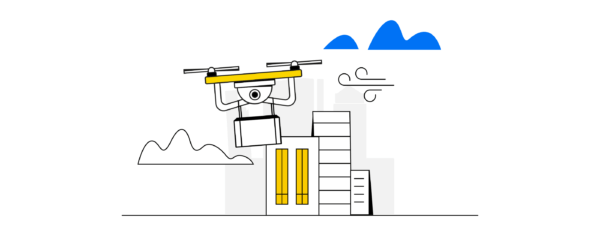
Yet drones are just as much at the mercy of the weather as drivers. When Uber Elevate tested the delivery of a Big Mac, chicken nuggets and fries by drone in San Diego, they had to cancel the trip because of the weather. This was due to a wind of 26 knots, which is classified as a “strong breeze” and above the limits set by the drone manufacturer.
The unpredictable nature of the weather is a common issue, whether you’re using drones, car drivers, or cyclists. If there is a snowstorm, extreme cold, heavy rain, or even just a strong breeze, it could slow down operations and allow fewer deliveries per hour.
If your app isn’t incorporating in-depth weather data, then you won’t be able to provide accurate ETAs and offer the kind of service necessary to secure customer loyalty.
Demand Analysis and Weather
The key to keeping customers happy while running more efficient and profitable operations is the ability to understand the spikes and valleys of demand. Finding ways to reduce costs and delays, be operationally efficient, and find core areas of revenue predictability is essential. This means staying one step ahead of the weather.
Looking at a manual day-to-day forecast of the weather isn’t going to be enough to accurately track delivery times and understand delays. This data can show you when there is traffic on the route right now, but it can’t tell you that there will be a massive storm tonight that will likely slow down traffic.
Instead, you need to integrate weather data into your platform and operational workflows so you can get the necessary insight to improve planning and make better decisions while proactively adapting to the incoming weather conditions.
Proactively Preparing for Demand Increase
If brands are able to effectively harness data to see exactly when, where, and how weather will impact their company, it represents a massive opportunity to build a lifetime of customer trust and loyalty.
Understanding how weather impacts your operations can be a key differentiator for your business in a number of ways.
Forecast demand
There is always a surge in demand for deliveries when the weather is bad. We already know:
- 49% of people are more likely to order pizza delivery during bad weather
Knowing when a storm is coming means you can adjust your operations to take the increase into account and ensure there is enough supply available to customers.
Restaurant delivery apps know they will need to prepare and staff up for demand surges. Companies that sell food or other essential items need to be able to access product supplies faster than their competition to ensure they have the necessary stock.
With the right weather intelligence solution, on-demand companies can know exactly when demand is going to surge and level off.
If you really want to make your business stand out, you can even let your customers know when there is likely to be bad weather and encourage them to get their order in early. Send out a push notification for “longer than usual ETAs” to encourage hungry diners to order sooner and miss the dinner rush.
This is a service people already want:
- 56% of people would like to receive notifications on their phone when the weather is going to be bad so they can schedule a pizza delivery in advance
Using predictive weather impact data for on-demand operations opens up a huge opportunity for your business if you have access to the right data via a weather API or a weather intelligence platform.
Below you can see an example of an impact dashboard for on-demand companies.
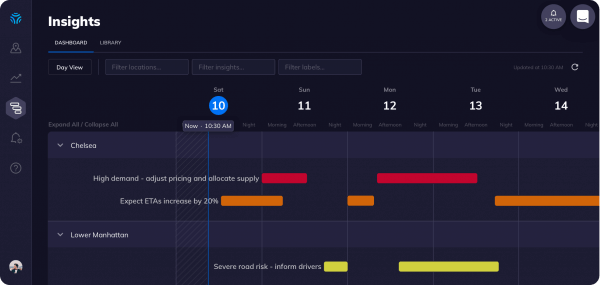
Ensure drivers are available and safe
If there is a storm on the way that will provide challenging conditions for your couriers, then you can warn them of the situation, advising them of potential issues, and suggesting the best route based on local, current data to keep them safe.
Tomorrow.io’s road risk scoring system helps drivers navigate through and around treacherous roads. The Road Risk Score alerts you to the specific level of risk at all points along your route in advance.
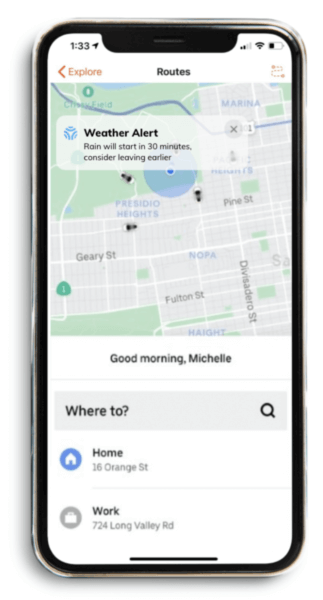
If the weather is safe to work in, you need to have enough drivers to meet increased demand. You can offer incentives to ensure you have enough couriers on the road to meet demand and offer timely ETAs. And with hyper-local weather data, you can understand the impact of weather at the street level and place incentives at the right time and location.
Provide accurate ETAs
Understanding demand, knowing how many couriers you have available, and being able to work out whether the weather will affect their route means you can offer up more accurate ETAs.
It’s important to always set realistic expectations for customers in advance.
You can do that by using hyperlocal weather data to set the ETA while once the courier is en route to the customer, taking into account any major delays they’ll face along their route, and updating the ETA in real-time as you get more data. This reduces the chance that they will cancel before the order reaches them.
Tomorrow.io’s weather intelligence API can improve ETAs by a full 25%. This means better customer service and, of course, happier customers.
Getting Ahead With Weather Intelligence
Having the right weather data in advance allows you to communicate earlier, better, and more often with both your couriers and your customers by sending weather-based alerts, such as delays, safety risks, and recommendations.
Did you know that Uber is already on board with weather intelligence? Early in 2020, Uber signed up to integrate the Tomorrow.io API across its entire platform. The Tomorrow.io API has helped illuminate the operational impact of weather elements such as rain, snow, winds, fog, temperature, and air pollution.
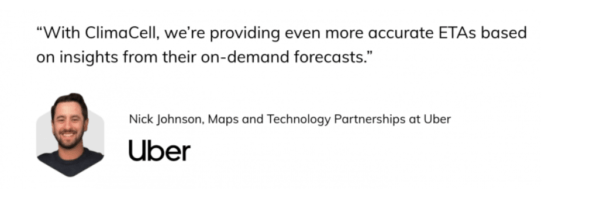
Uber now has a single trusted source of weather impact truth with automated team messaging and alerts. This ensures everyone is working off the same data, recommendations, and protocols 24/7.
Tomorrow.io allows Uber to make decisions in advance and in real-time. The software and API offerings allow teams to automate workflows and make business decisions seamlessly instead of worrying about the forecast.
It also uses Tomorrow.io’s Weather for AI (WAI) to generate historical weather information for millions of locations all around the globe. WAI allows you to take those historical learnings to utilize AI-driven insights, train your own models (or use ours), and predict future weather’s impact on your business.
We’re also partnering with other tech companies to help you get even more out of your weather data. Take our agreement with Zoba as a case in point.
Zoba’s demand forecasting and optimization algorithms combined with Tomorrow.io’s in-depth weather intelligence platform allow you to accurately predict and understand market conditions at the city block level and better forecast demand.
You can send out push notifications offering customers the ability to pre-order, and then incentivize more delivery drivers to be on the road for the upcoming storm to manage the surge in demand and keep ETAs low.
Want to offer more accurate ETAs while anticipating demand and saving money?
Learn more about weather intelligence.
